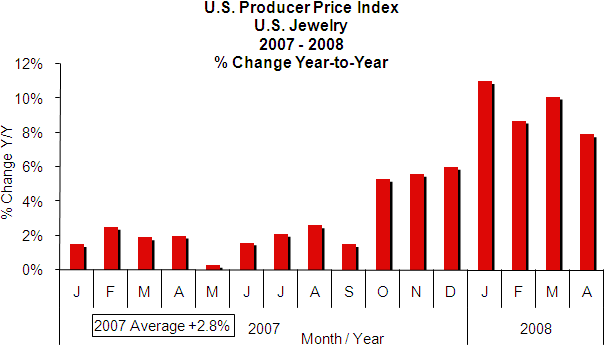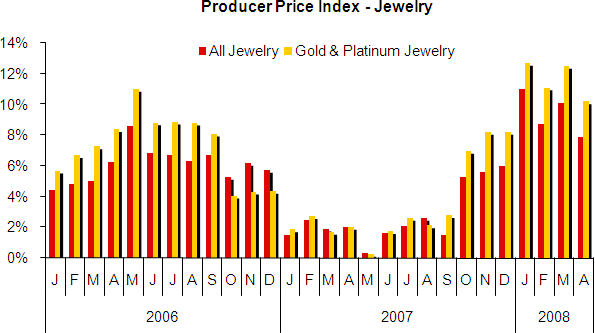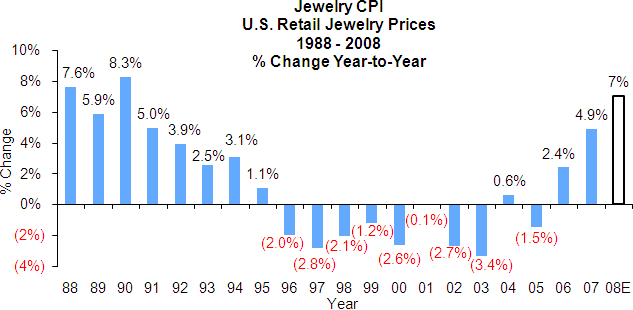IDEX Online Research: Jewelry Prices Surge at Retail & Wholesale Level
May 25, 08
Inflation is in the headlines daily: the price of flour is up, gasoline prices are soaring, and commodities continue to climb. In 2007, jewelry industry prices bucked the trend: they really did not rise much on an annual basis. But that’s all history now. Prices in the jewelry industry are surging, both at the wholesale supplier level and at the retail level.
Here’s the summary of inflation at the jewelry retail and supplier level for the month of April, as expressed as a percentage change year-over-year (April 2008 versus April 2007):
- Jewelry Producer Price Index +7.9%
- Jewelry Consumer Price Index +10.8%
While the Jewelry Producer Price Index (JPPI) has been rising steadily for the past few months, the surge in the Jewelry Consumer Price Index (JCPI) was the largest monthly gain since July 1992 (about 16 years ago).
It should come as no surprise that jewelry prices are finally rising. Gold, silver and platinum have posted sharp price gains over the past couple of years. While the average price for diamonds has barely inched up, prices for larger high quality diamonds have soared. In 2007, suppliers and retailers basically absorbed those rising prices one way or another. Further, inventory moves through the distribution pipeline very slowly (less than a one-time inventory turn annually for retail specialty jewelers), so jewelers didn’t feel the higher commodity prices on a “real time” basis, like automobile drivers feel every few days at the gas pump.
Finally, in late 2007, suppliers said “enough is enough,” and began telling merchants that they could pay higher prices or go elsewhere. Further, Sterling Jewelers publicly announced that it was raising retail prices in the first quarter of 2008; Zale also said it was reviewing retail prices. While no one else has blatantly said they are raising prices, the JCPI figures tell the story.
In March, retail price inflation for jewelry jumped dramatically, as specialty jewelers lined up to raise prices. Not only was there a lot of pent-up pressure to increase retail prices, but commodity prices at the wholesale and supplier level continued to show relentless increases.
Retail jewelers have finally gotten the message: raise prices or go out of business due to diminished gross margins. Similarly, suppliers have also raised prices for self-preservation reasons. Suppliers have more at stake, since their margins are often razor-thin; they can’t keep absorbing higher prices and remain in business.
Most commodities analysts are forecasting higher prices for the foreseeable future. We recognize, however, that prices and inflation run in cycles. We are currently in a period of high inflation. How long will it continue? One of the problems is that the financial markets are big players in running up commodity prices. Pure capitalism – with supply and demand balances – no longer is the sole determinant of prices. At some point, the greed factor among the global financial types will cause such an imbalance that prices could come tumbling down. We can’t say when it will happen, but there is no reason to believe that “things are different” this time around. Wait patiently: prices will moderate sooner or later.
Jewelry Producer Price Index (JPPI) +7.9% in April
U.S. jewelry producer prices rose sharply by 7.9 percent in April 2008, according to the Bureau of Labor Statistics (BLS). This was down modestly from March’s surge of 10.1 percent. Suppliers can no longer cope with steadily rising costs without passing the full brunt of those increases along to their customers. Most suppliers’ margins are much smaller than retailers; they simply don’t have the profit cushion to continue absorbing higher costs. There were broad hints in the JPPI during the final quarter of 2007 that this inflation surge was materializing. After nine months of modest supplier price increases in 2007, the JPPI jumped substantially in the fourth quarter of 2007, and leaped in January. This year’s JPPI surge is not a statistical aberration; it is real.
While the JPPI in February, March, and April moderated from January’s near record of +11.0 percent, it is a harbinger for prices this year, in our opinion.
Inflation rate comparisons so far this year have been relatively easy against last year’s 12-month gain of 2.8 percent gain in the JPPI. This trend of easy comparisons continues for several more months. That is likely to result is some significant gains in JPPI, simply due to the way the math is calculated. However, don’t be fooled: jewelry commodity inflation is rampant.

Source: BLS
What’s behind surging prices at the wholesale and supplier level in the jewelry industry? It will come as no surprise that precious metals prices are the main culprit. The graph below compares the JPPI (red bars) to inflation for precious metals (gold bars); gold is the primary driver of precious metals inflation.

Source: BLS
Jewelry Consumer Price Index (JCPI) +10.8% in April
U.S. jewelry consumer prices surged by 10.8 percent in April, as calculated by the BLS. This is the second consecutive month that jewelry prices at the retail level have surged. In February, we had predicted that the modest gains in the JCPI would end (we said “this is the calm before the storm”); we are not exactly patting ourselves on the back, but retail prices of jewelry were destined to surge, due to the pent-up pressure at the wholesale level.
Fortunately, for the industry, many jewelers followed the lead of Sterling and Zale, both of who announced that they would be raising prices by the end of the first quarter.
April’s gain in the JCPI of 10.8 percent was the largest monthly gain since July 1992. While that month 16 years ago appears to be an aberration, the industry was just coming off a period of high inflation in the 1988-1990 period.
It will not surprise us to see continuing high jewelry price inflation at the retail level for the next several months.
The only good news is that this is an excellent time for retail jewelers to raise prices. Unfortunately, there really isn’t much price elasticity related to demand at the retail level in a recessionary environment. Shoppers are already in a mental recession, and no level of price concessions – short of giving goods away – is going to create significant store traffic and demand. With little store traffic, jewelers can selectively raise prices without causing havoc to demand. When the economy recovers, retailers will have their new prices in place, and consumers won’t know the difference.

Source: BLS
Outlook: Higher Prices Remain on the Horizon
Our forecast calls for both jewelry consumer prices and jewelry producer prices to rise by about 7 percent in 2008. We’re going to stay with those forecasts, even though they are a bit tentative, given the surge in both the JCPI and the JPPI over the past couple of months. For sure, prices are headed higher as suppliers and retailers attempt to recoup large costs increases which have hit the industry over the past three years or so.

Source: BLS